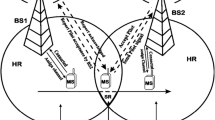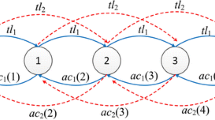Abstract
The macrodiversity changes the required transmission power to serve a mobile station according to its location. It helps to improve system performance but also causes unexpected call-dropping after handoff. This effect has been neglected when only voice service is provided. But for multimedia traffics which require high data rates, it should be considered. In this paper, we develop a new analytic model of soft handoff considering this effect. Performances have been evaluated with respect to the blocking probability, the handoff failure probability and the region-transition failure probability, using analytic and simulation method. Especially, the region-transition failure probability is a newly introduced performance factor that has been neglected in previous research. Numerical results are compared with previous analytic model to show the effect of macrodiversity on the system performance. The results of this paper can be used for the system management such as determinations of an optimal resource allocation, a cell configuration, and an admission strategy.
Similar content being viewed by others
References
Viterbi, A. J., Viterbi, A. M., Gilhousen, K. S., & Zehavi, E. (1994). Soft handoff extends CDMA cell coverage and increase reverse link capacity. IEEE Journal on Selected Areas in Communications, 12(8), 1281–1288.
Lee, C.-C., & Steele, R. (1998). Effect of soft and softer handoffs on CDMA system capacity. IEEE Transactions on Vehicular Technology, 47(3), 830–841.
Zhang, N., & Holtzman, J. M. (1995). Analysis of a CDMA soft handoff algorithm. In Proc. PIMRC95 (pp. 819–823).
Agarwal, S., & Holtzman, J. M. (1997). Modeling and analysis of handoff algorithms in multicellular systems. In Proc. VTC97 (pp. 300–304).
Su, S. L., Chen, J. Y., & Huang, J. H. (1996). Performance analysis of soft handoff in CDMA cellular networks. IEEE Journal on Selected Areas in Communications, 14(9), 1762–1769.
Narrainen, R. P., & Takawira, F. (2001). Performance analysis of soft handoff in CDMA cellular networks. IEEE Transactions on Vehicular Technology, 50(6), 1507–1517.
Chung, Y., & Cho, D. H. (2003). Performance evaluation of soft handoff for multimedia services in intelligent transportation systems based on CDMA. IEEE Transactions on Intelligent Transportation Systems, 4(4), 189–197.
Wang, X., Xie, S., & Hu, X. (2009). Recursive analysis for soft handoff schemes in CDMA cellular systems. IEEE Transactions on Wireless Communications, 8(3), 1499–1507.
Elayoubi, S.-E., Chahed, T., & Hebuterne, G. (2007). Mobility-aware admission control schemes in the downlink of third-generation wireless systems. IEEE Transactions on Vehicular Technology, 56(1), 245–259.
Tarhini, C., & Chahed, T. (2008). On mobility of voice-like and data traffic in IEEE802.16e. In Proc. Globecom (p. 2008).
Choi, W., & Kim, J. Y. (2001). Forward-link capacity of a DS/CDMA system with mixed multirate sources. IEEE Transactions on Vehicular Technology, 50(3), 737–749.
3rd Generation Partnership Project (2005). Technical specification group radio access network; radio resource management strategies (3GPP TR 25.922 version 6.2.0 2005-10, release 6).
3rd Generation Partnership Project (2005). Technical specification group radio access network; radio resource control (RRC) protocol specification (3GPP TR 25.331).
Cheng, M., & Chang, L. F. (1998). Uplink system performance of high-speed IS-95 CDMA with mixed voice and bursty data traffic. In Proc. IEEE PIMRC’98 (pp. 1018–1022), Boston, MA.
Schwartz, S. C., & Yeh, Y. S. (1982). On the distribution function and moments of power sums with lognormal components. The Bell System Technical Journal, 61(7), 1441–1462.
Jansen, M. G., & Prasad, R. (1995). Capacity, throughput, and delay analysis of a cellular DS CDMA system with imperfect power control and imperfect sectorization. IEEE Transactions on Vehicular Technology, 44(1), 67–75.
CDMA Systems Engineering Handbook (1998). Reading: Artech House.
Author information
Authors and Affiliations
Corresponding author
Additional information
This work is supported by Basic Science Research Program through the National Research Foundation of Korea (NRF) funded by the Ministry of Education, Science and Technology (2010-0005684) and the Research Grant of Kwangwoon University in 2009.
Rights and permissions
About this article
Cite this article
Chung, Yu., Park, S. Performance evaluation of soft handoff considering macrodiversity effect in multimedia CDMA systems. Telecommun Syst 53, 179–194 (2013). https://doi.org/10.1007/s11235-011-9527-z
Published:
Issue Date:
DOI: https://doi.org/10.1007/s11235-011-9527-z




